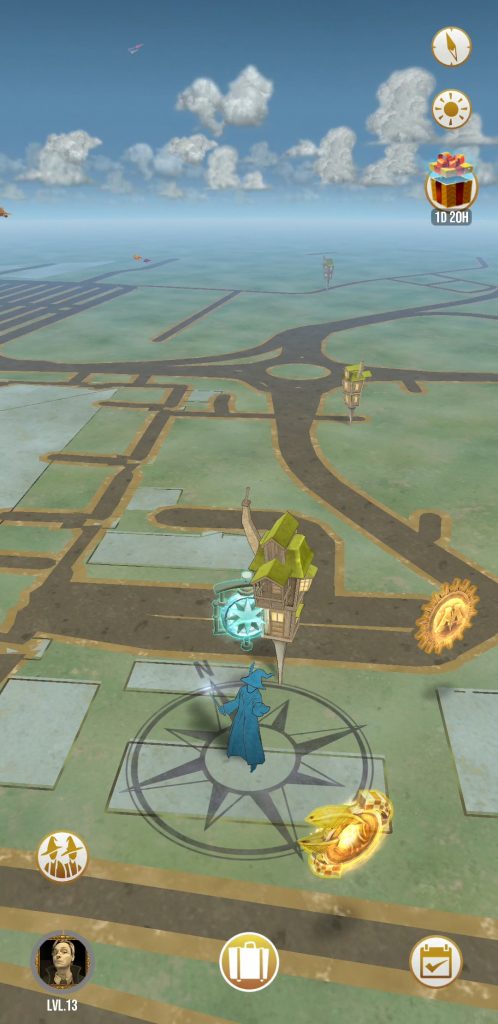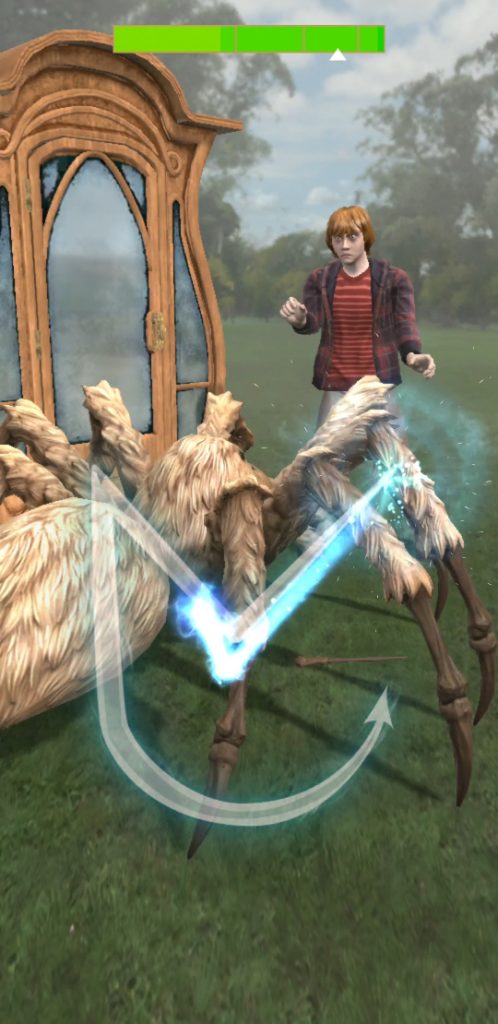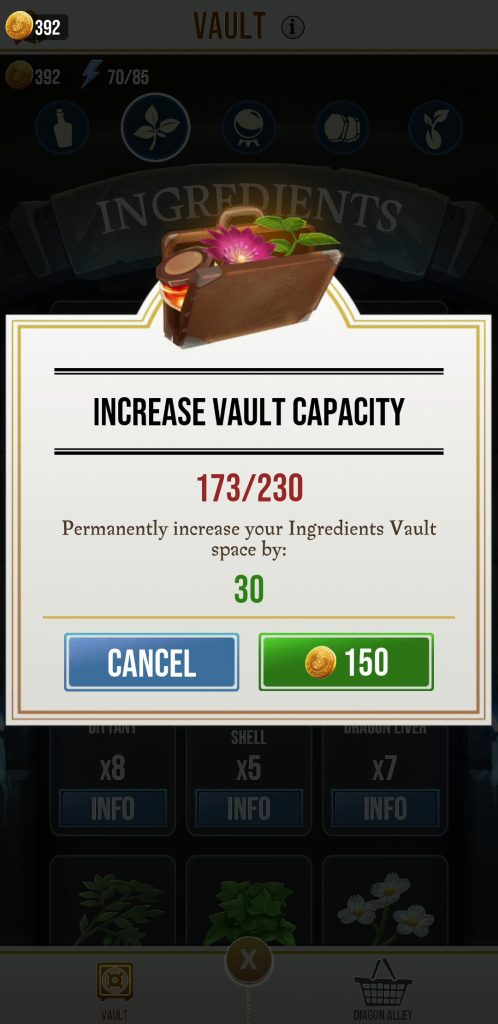The latest Free-to-Play game from Pokémon Go creators Niantic is set in the Harry Potter universe and tries to be more of a game than the Pokémon collect-em-all-a-thon. Does it really live up to its source material and is it more game than Pokémon thanks to its RPG mechanics?
If It Isn’t Harry Potter

Upon launch what first catches your eye is the outstanding production value. Everything oozes AAA-quality (at least in terms of mobile games), you get good (!) voice acting, detailed models and animations of characters and oddities to lure you in as John Williams’ music sets the mood. Potterheads feel nothing but welcomed, and even I found the first few minutes very entertaining and intriguing.
The story is negligible, it’s about a strange calamity that threatens the world by scattering magical objects all over it. As players, our task is to return these so-called foundables by magic. Sometimes these are guarded by “confoundables,” but the gameplay remains the same. For those who are familiar with Pokémon Go, “Returning foundables” is the equivalent of catching Pokémon, “inns” are points of interest on the map like Pokéstops to recharge your magic wand, the Fortresses (more on those later) are akin to the arenas where you go to battle and raid.
Hitting the Bars (the Progress Ones)
After getting your bearings, you walk around your real life neighborhood to do the Ministry of Magic’s busywork on your phone. The game is proud of its AR capabilities meaning you will see the sparkling magical entities overlaid in real time on what your camera sees and you can walk around them as if they were there. This is as gimmicky as it gets, and soon I turned that feature off to speed things up and conserve battery power.

So you walk around, visit “inns” to recharge your wand to keep playing, pick up random ingredients popping up around you and just keep doing things until you run out of spell energy or fill up your inventory, either happens pretty quickly. The game showers you with daily quests, special quests, and events to guide you through its features and to tell you its story bit by bit in a graphic novel style. There are no dialog options to choose from, just tap for the next line until you’re out in the wild again. There are dozens of individual bars to make progress on, everything sparkles and drops meager rewards such as a handful of experience points, potions, a few coins, or potion brewing ingredients. In short, more stuff to occupy valuable inventory space.
Traces

But what do you actually do when you’re not tapping on completed bars to trigger their respective rewards? To return foundables in the encounters or to battle mighty enemies, all you have to do is trace shapes the game prompts you with your fingers, the faster and the more accurate, the better.
There is no tactical element of picking the right spell for the right occasion, of switching between offense and defense yourself, or, in short: Real player agency. Your choices are limited to taking a potion or not, or whether to flee from an encounter. Outside you collect your rewards from progress bars, put potions in the queue, and manage your eternally cluttered inventory by throwing out superfluous odds and ends.
Expecto Pokémon!
Every cast, successful or not, consumes “spell energy” that you have to recharge at the mentioned inns that are points of interest on the map, just as you would collect pokéballs at pokéstops. Of course, you can always buy spell energy anywhere with in-game currency at a hefty price. At the time of writing fifty spells cost hundred gold coins; eighty of the latter cost 1.09 €. In comparison, it takes half a week to earn 100 coins in the game, provided you play daily and play extensively.

Like any respectable money-grab, also Wizards Unite starts you woefully underequipped. “Oh no, your bag is full, you can’t pick up any more ingredients! You can’t collect more than 65 spell energy! Your potions hit the maximum! Seeds and water vault is full!” The game, however, is happy to offer you convenient solutions to its artificial problems as most anything can be overcome by spending a few gold coins, the game’s in-game currency.
Want to brew a potion but don’t have all the ingredients? It’s just a few coins. You want said potion now and not in eight hours? A few more coins, please. Need more slots in your vault? Coins. You get the picture. Yes, the monetization is strong with this one.
Better Together
The most “game” you get out of is raiding fortresses, ideally with other players. There, you all have to defeat a certain number of foes in a certain amount of time. If you die, pardon, run out of stamina, you have to sit out for thirty seconds, increasingly longer should you fail repeatedly. The fights themselves are more of the same: Trace the prompted shapes on the screen and down potions to restore your health stamina, and to boost your attacks. Between fighting individual foes, you can buff your fellow wizards or weaken enemies. Depending on your class (profession, as the game calls it) you have different abilities at your disposal, which you can gradually unlock and improve by climbing the skill tree. It’s possible to switch professions at any time, but you can’t redistribute previously invested skill points.

It’s absolutely reasonable to play different tiers of these raids alone, but they are intended to be tackled together; ideally with friends on the same level as you but with different professions, all being at the same physical location as you at the same time. I played the game during the week and on the weekend and frequented popular spots in the city. Apart from my wife, who was fighting alongside, I never met another player in the week I have been playing. Considering that the game just came out, that’s a far cry from the throngs of people that would gather at the same places during the heydays of Pokémon Go.
Invisible Dice
To me most aggravating about the whole game is not even the dumbed-down simplicity of the gameplay, nor is it the countless hours of my life I had to wait for the animations to play out before the game would grant me another attempt, no, it’s the lack of feedback.
As with Pokémon Go, succeeding in an encounter feels entirely random. While the game tells you whether your spellcasting was “Fair,” “Good,” “Great,” or “Masterful,” it feels like it doesn’t figure at all. Many times a target might resist your “masterful” magic, other times even a “fair” cast will get the job done at the first attempt.
As with catching Pokémon, there is no indication on how close you came (or not), or how many attempts you still got before your adversary departs leaving you with nothing. It is incredibly frustrating spending a sizeable amount of time, potions, and spell energy on something that vanishes all of a sudden.
Time-Turner
Another aspect that becomes a nuisance is how long the game makes you wait for everything and how little choice you have anyway. While the encounters are wonderfully modeled, animated, and dubbed, you can’t skip animations. It starts with a few seconds of introduction until you are prompted to cast a spell. It takes a couple of seconds to see the outcome of that (possibly followed by one or many retries) before you have to watch the ending animation.
I timed an average encounter with a vampire. The whole thing lasted 48 seconds, 37 of which I could not interact in any way, which is over three quarters. It doesn’t sound much, but it accumulates quickly, after a hundred similar encounters, the game made you wait for close to an hour.
As mentioned earlier, outside of these encounters, all you do is check on the status of the menagerie of progress bars, tap the completed ones to get your rewards and … that’s it.
Closing Remarks
While at least enticing to Harry Potter fans to experience that evocative universe in a new medium, at its heart the game tries little to be engaging earnestly by its mechanics. Its production value and barrage of rewards might draw you in, but the experience is only skin deep. You’re not a participant in the story it tries to tell, you’re an observer in another aggressively monetized product that’s designed to drip-feed you the fun you’re allowed to have at a time—unless you pay up. At the time of writing, I am at level 15, and my only hope is that the developers keep adding to the game in the future. While it won’t ever become Skyrim, it still has potential.
If you had fun with Pokémon Go, it wouldn’t hurt to try out Wizards Unite as it is a little more of the same, but for anyone looking for a fulfilling game that respects your time and investment, stay away.